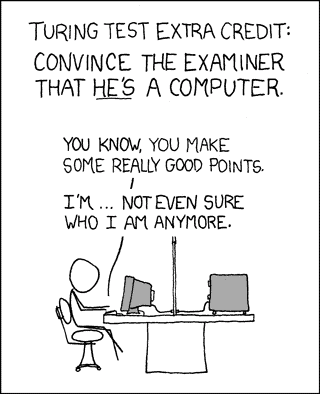I’ve long since resigned myself to being the “tech guy” wherever I live. (Among the joys this brings to my life are: knowing where every WiFi access point is hidden in the ceilings, conversations that begin “I’m so glad to see you — my computer just crashed,” and serving as webmaster at TJP.)
A few weeks ago, however, I discovered a theological application for my computer science training: the Ideological Turing Test for religion (version 2) running at Leah Libresco’s Unequally Yoked.1
Unequally Yoked is a blog run by the great website Patheos. It runs with the tagline “a geeky atheist picks fights in good faith,” which is much pithier than TJP’s initial headline: “we are in over our heads.” I wish I could remember how I first came Unequally Yoked, but it made its way into my Google Reader account, and there it’s stayed ever since. I’ll just offer this promo: in addition to being one of the brightest writers I’ve encountered in apologetics, Leah Libresco is one of the few atheists I’ve read who has a grasp of the internal coherence and attraction of Christianity, a fact that makes her an intellectual joy to read.
Onto the Turing test. Invented by the famous Alan Turing, the test attempts to determine when can we say that a computer has achieved human-equivalent intelligence.2 Turing’s answer — when we can no longer tell them apart by looking at their answers. He proposed putting a computer in one room, a human in another, and an examiner posing questions in a third. If the interviewer can’t reliably distinguish between the two, then we can call the computer “intelligent.”
 Inspired by Bryan Caplan’s idea of an Ideological Turing Test, Libresco decided to run a Turing-like test between atheists and Christians. In her test each group has to pose as the other while answering a select set of questions.
Inspired by Bryan Caplan’s idea of an Ideological Turing Test, Libresco decided to run a Turing-like test between atheists and Christians. In her test each group has to pose as the other while answering a select set of questions.
So, why have I imperiled your lunch hour by providing all these links? Well, mostly because this is wildly cool use of the web — something that simply wouldn’t/couldn’t have happened without the blogosphere. But even more importantly, it’s an example of a kind of dialogue that is all too infrequent. It’s terribly easy to fall into kind of ideological echo chamber, where we focus our attention only on those things with which we already agree.3
Escaping the echo chamber starts with a simple question: Can you explain why a rational, compassionate, and reflective person would disagree with you?
If an answer to that question eludes you, then finding one has to be the first order of business. Assuming that those we disagree with are malicious, stupid, power-hungry, and/or sociopathic is the easy way out. It works against charity, and (not coincidentally), it also works against real dialogue and the possibility of conversion.
Libresco’s version of the Turing test is, I think, that rare entry in the religion/atheism dialogue that provides more light than heat. And for that she deserves both our thanks and our attention.
Author’s note: we haven’t yet focused much on the topic of arguments about atheism and belief — so if you’re interested, let us know, and I may go browsing through some of the Turing Test entries on Unequally Yoked for future posts. Or perhaps we could run a Jesuit/Franciscan/Dominican Turing Test of our own?
— — — — —
- Time-sink warning: if you are at all geeky, or at all interested in the question of belief and unbelief those links will steal away precious summer hours better spent in the sun. But they’re well worth it. ↩
- Like a number of clever solutions in computer science, it’s essentially a dodge around a otherwise intractable problem (in this case, defining intelligence). The genius of the test, of course, is that it gives a procedural formality to a squishy “I’ll know it when I see it” definition. ↩
- I’d say that we face this danger as much in debates internal to the Church as in those with non-believers; you can provide your own examples, or refer to Eric Sundrup’s post on comment boxes. ↩



